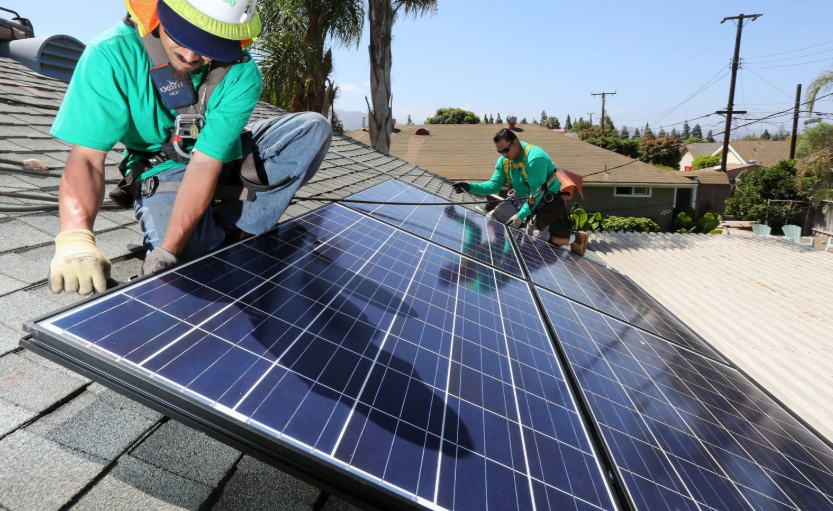
Can I Install Solar Panels on a Flat Roof? Here’s What You Should Know
When people think about solar panels, they often imagine sloped, sunny rooftops soaking in the sun’s energy. But what if your roof is flat? Is solar still a smart choice?
The answer is a big yes. In fact, flat roofs can be ideal for solar—if you plan correctly.
In this guide, we’ll explore everything you need to know about installing solar panels on a flat roof, from how it works to design considerations, installation options, pros and cons, and key tips. Whether you’re a homeowner or a commercial property manager, this is your go-to resource.
✅ Can You Install Solar Panels on a Flat Roof?
Yes, solar panels can be installed on flat roofs effectively. In fact, flat roofs often provide more flexibility in design and orientation compared to angled roofs.
With the right Solar PV Panel Design and Installation, your system can be just as efficient—if not more so—than a traditional rooftop setup.
🏠 How Do Solar Panels Work on Flat Roofs?
Flat roofs require a slightly different installation approach. Since they don’t naturally tilt toward the sun, you’ll need mounting systems that adjust the angle of the panels to maximize sunlight exposure.
There are two main mounting options:
1. Ballasted Mounting Systems
-
Panels are attached to racks that sit on the roof without penetrating it.
-
Weighted down with concrete blocks to keep them in place.
-
Ideal for roofs that can support the weight and need minimal penetrations.
2. Penetrating Mounting Systems
-
These systems are bolted into the roof structure.
-
Offers greater wind resistance.
-
Required when the building code, local weather, or roof material doesn’t allow ballasted systems.
🌞 Benefits of Flat Roof Solar Panel Installation
There are several reasons to consider solar for your flat roof:
1. Optimal Sun Angle
With sloped roofs, you’re stuck with the roof’s natural angle. Flat roofs allow you to choose the best tilt and orientation for your region’s solar exposure.
2. Easier Maintenance
Flat roofs make it easier to:
-
Clean the panels.
-
Perform maintenance.
-
Upgrade systems if needed.
3. More Space for Expansion
You can place more panels on a flat roof because there’s less interruption from chimneys, skylights, or dormers. Plus, commercial buildings often have larger flat roof areas than homes.
4. Lower Installation Costs
The labor costs can be lower because of easier access and safer working conditions for installers. No climbing on steep angles!
⚙️ Key Considerations for Solar PV Panel Design and Installation on Flat Roofs
Getting the design right is crucial for energy efficiency and return on investment. Here are the most important factors to keep in mind:
✅ 1. Roof Load-Bearing Capacity
Your roof needs to handle the weight of the solar system, including panels, racking, and (if used) ballasts.
Tip: A structural engineer can assess this before installation.
✅ 2. Tilt Angle
Solar panels should ideally be tilted at an angle between 15° and 40° depending on your geographic location. This tilt helps:
-
Maximize sun exposure.
-
Reduce dirt accumulation (since rain can wash debris off).
✅ 3. Row Spacing (Avoiding Shadowing)
Each row of panels must be spaced properly so one doesn’t shade the next—especially important on flat roofs.
✅ 4. Wind Resistance
Flat roofs are more exposed to wind uplift. Systems must be engineered to stay secure during storms.
✅ 5. Drainage and Water Flow
Installers must ensure that the racking system doesn’t block drainage paths. Ponding water can damage roofing materials and decrease panel lifespan.
✅ 6. Roof Access and Compliance
Solar PV Panel Design and Installation must allow:
-
Clear pathways for rooftop access (for HVAC units or inspections).
-
Compliance with local fire codes and regulations.
🧰 Solar Panel Installation Process on Flat Roofs
Here’s what the typical installation process looks like:
Step 1: Site Inspection
A solar installer visits your property to assess:
-
Roof condition and structure.
-
Sunlight availability.
-
Electrical system compatibility.
Step 2: System Design
Using tools like drone mapping and solar software, the team creates a customized Solar PV Panel Design. For flat roofs, this includes calculations for tilt, spacing, and ballast.
Step 3: Permits and Approval
Installers handle the paperwork, including building permits and utility interconnection approvals.
Step 4: Installation
-
Racks are assembled and either anchored or ballasted.
-
Panels are mounted.
-
Wiring and inverters are installed.
-
Electrical connections are tested.
Step 5: Inspection and Activation
After the utility and local building authority approve the system, your solar panels are activated, and you start generating clean energy!
🏢 Flat Roof Solar Panels for Commercial Buildings
Flat roof solar isn’t just for homes—it’s a top choice for commercial buildings. Here’s why:
-
Large roof surface = more panels = higher energy output.
-
High energy use during the day (perfect timing for solar generation).
-
Tax incentives and rebates can significantly reduce upfront costs.
Many businesses also enjoy the PR value of going green, which can attract eco-conscious customers.
🔄 Should You Add a Battery?
Adding battery storage to a flat roof solar system is a smart upgrade if:
-
You live in an area with frequent blackouts.
-
You want to go off-grid.
-
You want to maximize your savings during peak utility hours.
Batteries like the Tesla Powerwall or Enphase IQ Battery can be installed alongside your panels for energy security.
⚖️ Pros and Cons of Solar Panels on Flat Roofs
| Pros | Cons |
|---|---|
| Custom tilt and direction | May require ballasts or penetrations |
| Easier and safer for maintenance | Slightly lower energy production per panel |
| Flexible layout options | Potential for wind uplift if not designed well |
| Cheaper installation labor | Needs careful drainage planning |
| Great for large surface areas (commercial) | Slight shading issues if not properly spaced |
💡 Cost of Installing Solar Panels on a Flat Roof
Costs vary depending on your system size and location, but here’s a general idea:
-
Residential systems: $10,000–$30,000 before incentives.
-
Commercial systems: $50,000+ for larger installations.
Good news: You can apply federal tax credits (up to 30%), local incentives, and financing options like solar leases or PPAs.
🌎 Is Solar Right for Your Flat Roof?
In most cases—yes. Whether you own a home, warehouse, school, or office building, flat roofs offer:
-
A great platform for sustainable energy.
-
A long-term reduction in electricity bills.
-
A boost in property value.
The key is working with an experienced team that understands Solar PV Panel Design and Installation tailored specifically to flat roofs.
🔧 Final Tips Before You Go Solar
-
Choose experienced installers with flat roof solar expertise.
-
Ask about warranties on both the panels and the installation work.
-
Consider long-term roofing needs (if your roof is 15+ years old, consider replacing it before installing panels).
-
Get multiple quotes and compare design strategies.
❓FAQs: Installing Solar Panels on a Flat Roof
Q1: Will solar panels damage my flat roof?
No, not if they’re installed correctly. Ballasted systems avoid drilling into your roof, and all systems should use waterproofing methods to prevent leaks.
Q2: Do I need to reinforce my roof before installing solar panels?
Sometimes. A structural assessment will determine if reinforcement is needed based on the weight of the panels and racking system.
Q3: Can I install solar panels on a flat roof myself?
It’s not recommended. Flat roof systems require precise design and mounting to avoid wind uplift, drainage issues, and fire code violations. It’s best left to professionals.


